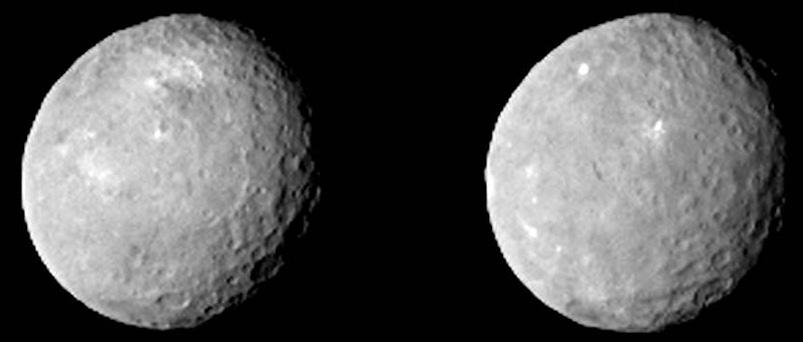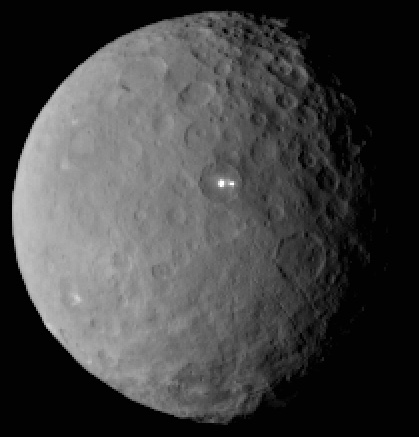Puzzling bright spots on dwarf planet Ceres
February 27, 2015

These two views of Ceres were acquired by NASA’s Dawn spacecraft on Feb. 12, 2015, from a distance of about 52,000 miles (83,000 kilometers) as the dwarf planet rotated. The images have been magnified from their original size. (credit: NASA/JPL-Caltech/UCLA/MPS/DLR/IDA)
Cruising through the asteroid belt, NASA Dawn spacecraft is approaching dwarf planet Ceres, and some puzzling features are coming into focus, revealing craters and mysterious bright spots.
“We expected to be surprised by Ceres,” says Chris Russell, principal investigator of the Dawn mission, based at UCLA. “We did not expect to be this puzzled. … As Dawn has come closer to Ceres, the bright spots have become brighter and smaller. Indeed, they are much brighter than the surrounding landscape and still unresolved in our images. The point of origin must be very small.”
But it gets weirder. On Wednesday Feb. 25, Dawn’s mission director, chief engineer and lead blogger Marc Rayman posted this new higher-resolution image, showing not one, but two adjacent bright spots:

(credit: NASA / JPL-Caltech / UCLA / MPS / DLR / IDA)
Curiously, “even though Ceres is in the asteroid belt, it is entirely unlike asteroids,” says Rayman. “Ceres apparently formed far enough from the sun under conditions cool enough for it to hang on to water molecules,” writes Rayman in his blog. “Indeed, scientists have good reason to believe that water (mostly in the form of ice) may make up an astonishing 30 percent of its mass. Ceres may contain more water than Mars or any other body in the inner solar system except Earth.”
Stay tuned. On March 6, Dawn will be gently captured into orbit around Ceres, beginning a mission to map, explore and understand the dwarf planet. By the time Dawn is in its lowest altitude orbit at the end of this year, its pictures will be well over 800 times better than Hubble’s.